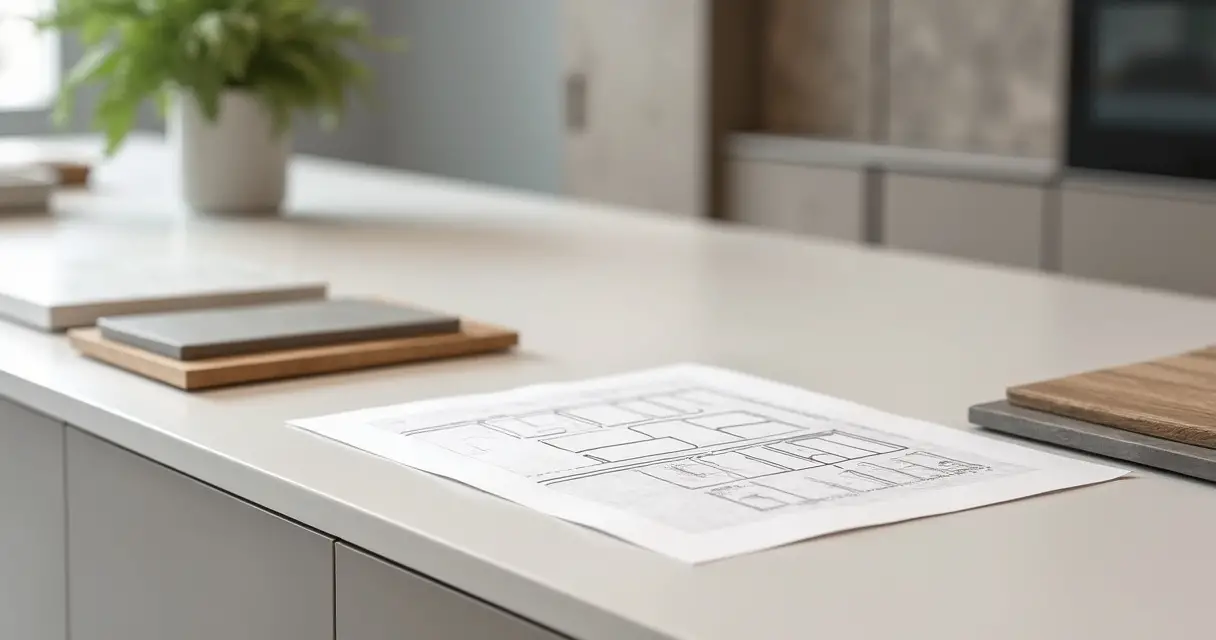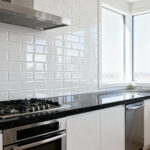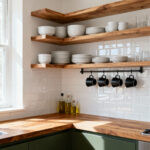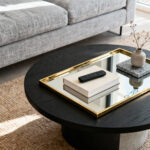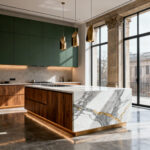You know what people always ask me? They see these beautiful, stark-white kitchens in magazines and ask, “How can I get that look?” But honestly, that’s the wrong question. The real question is, “How do I create a kitchen that works beautifully, makes me feel good, and doesn’t trash the planet in the process?” Because a truly contemporary kitchen isn’t just about a minimalist look—it’s about a minimalist approach to waste, stress, and inefficiency.
A lot of what passes for “contemporary design” is just a collection of trends that will look dated in five years. The real story, the stuff that actually matters, is in the thinking behind the choices. It’s about creating a space that’s incredibly functional, easy to maintain, healthy for your family, and gentle on our environment. These aren’t just decorating tips; they’re principles for building the true heart of your home. Forget the noise and corporate speak—here’s how you actually do it right.
Laying the Foundation: Strategic Planning for Your Modern Kitchen (Part 1)
Before you even think about a single cabinet color or countertop material, we have to talk about the blueprint. This is where most people go wrong. They jump straight to the pretty stuff and end up with a kitchen that looks great on Instagram but is a nightmare to actually use. This first phase is all about intention—designing a space from the inside out, based on your real life, not a fantasy one.
1. Conduct a Lifestyle-Driven Needs Assessment
Forget the trends for a second. The most important question is: how do you actually live? Are you a frantic weekday breakfast parent, a weekend baker, a big-time entertainer? A kitchen designed for a gourmet chef who cooks for two is going to be wildly different from one designed for a family of five that lives on batch-cooked meals. Thinking about this isn’t just navel-gazing; it’s the absolute foundation of a kitchen that won’t make you miserable.
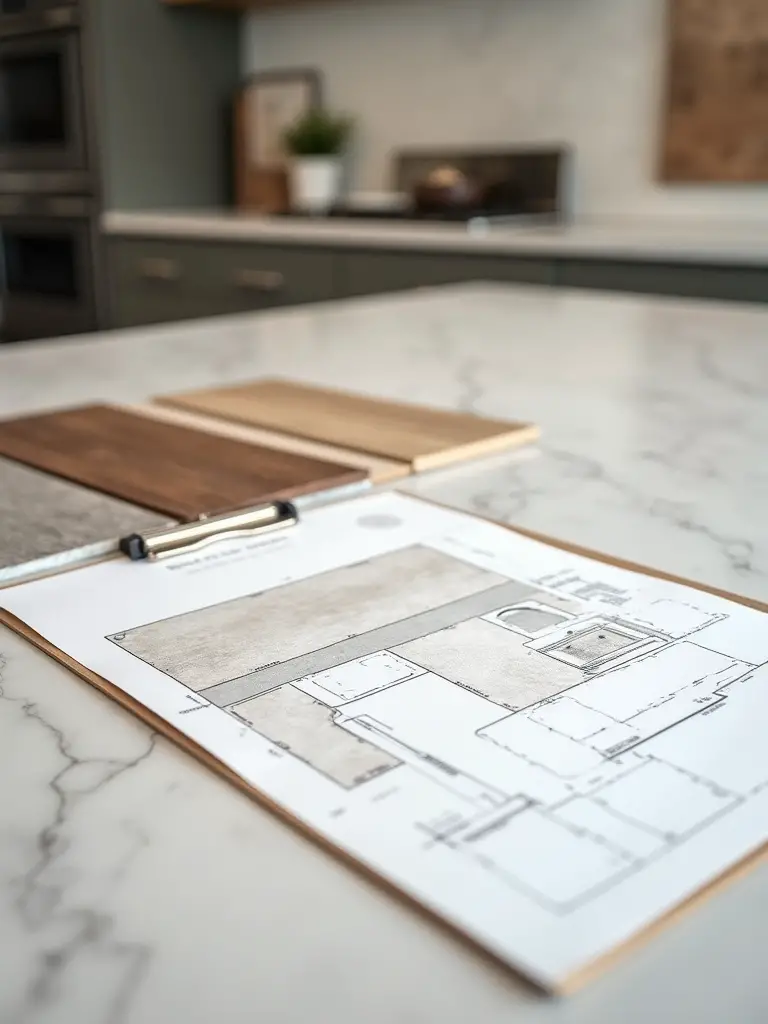
I once worked with a family who was convinced they needed a massive six-burner gas range because it looked so professional. But after we talked, we realized what they actually needed was a huge, durable island where the kids could do homework while they made dinner, and a super-efficient induction cooktop that was safer for little hands and didn’t pump fumes into their open-plan living space. That conversation saved them thousands and resulted in a kitchen they truly loved and used.
Thinking about your real-world needs first is the shortcut to getting a design that feels like it was made just for you—because it was. This is how you avoid a space filled with expensive, beautiful regrets.
2. Prioritize Open-Concept Layouts and Flow
Okay, “open-concept” is a buzzword, but there’s a real reason it’s a cornerstone of contemporary design. It’s about connection. It’s about letting natural light flood your home and allowing the person cooking to be part of the conversation, not isolated in a culinary cave. It makes your whole home feel larger, brighter, and more communal. But here’s the BS no one tells you: a poorly planned open concept is just one big, noisy, smelly room.
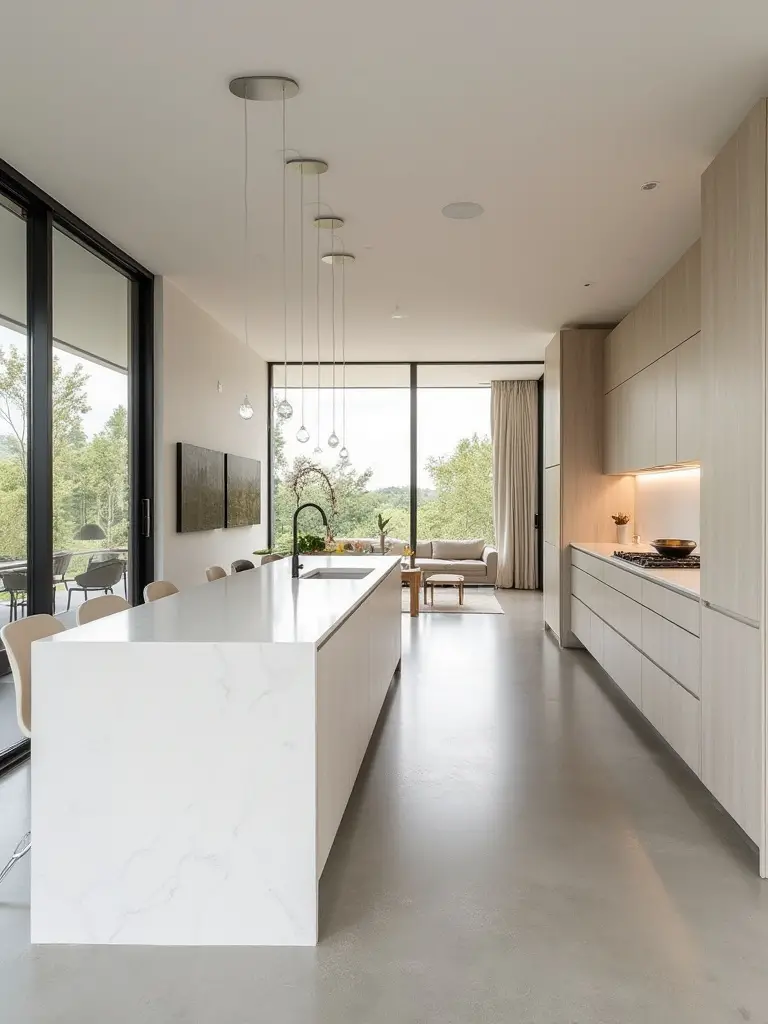
What actually matters is the flow. You need to create distinct “zones” for cooking, prepping, and socializing without putting up walls. This is where an architectural island comes in (more on that later). And for the love of all that is good, you absolutely must invest in powerful, quiet ventilation. Otherwise, the salmon you cooked on Tuesday will still be a guest in your living room on Thursday. True contemporary design solves these problems elegantly, creating a space that’s both connected and respectfully zoned.
So as you think about tearing down walls, also think about how you’ll manage sound, smells, and traffic. A great Open-concept kitchen doesn’t just feel open; it feels smart.
3. Define a Cohesive Color Palette and Material Scheme
This is where my inner environmental scientist gets excited. A cohesive palette isn’t just about picking colors you like; it’s about choosing materials that are healthy, durable, and sustainable. The typical approach is to grab a dozen paint chips and hope for the best. The Jacob approach is to start with a foundational material—maybe reclaimed wood for shelving, or a recycled paper composite countertop—and build the palette from there.
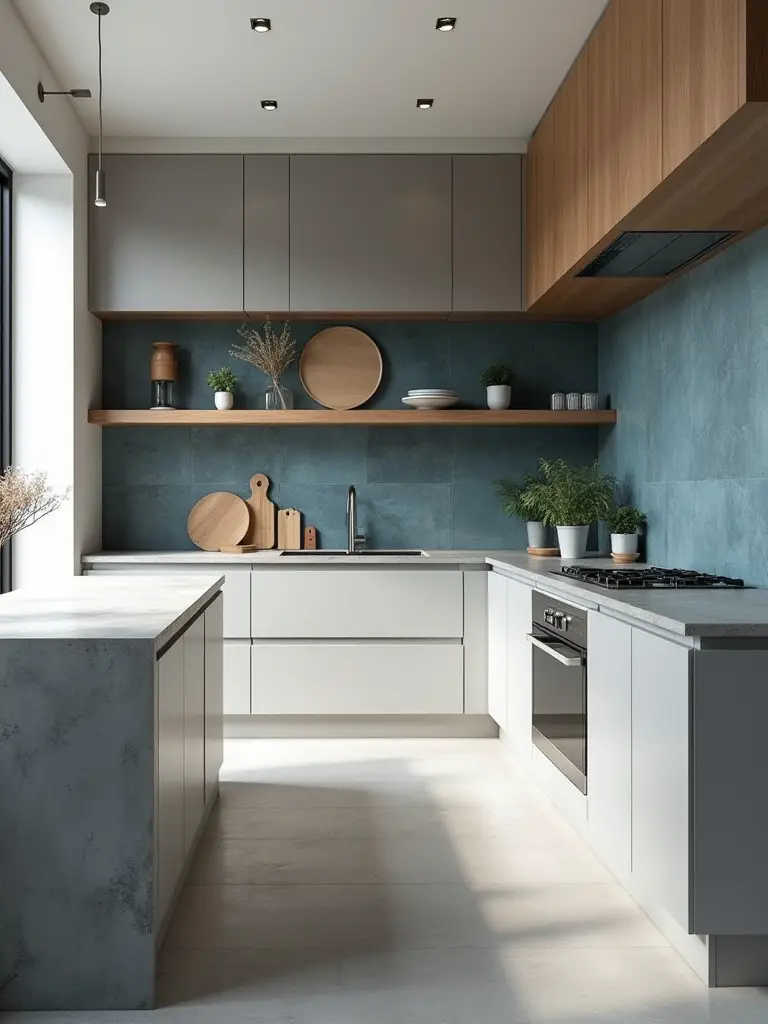
Focus on a tight range of 2-3 neutral, calming tones for your big surfaces (cabinets, walls) and then introduce texture for interest. This is the secret to a space that feels serene, not sterile. Think about the difference between a high-gloss white box and a room with matte off-white cabinets, a honed (not polished) stone backsplash, and warm wood accents. One is a showroom; the other is a sanctuary. And please, for your health and the planet’s, choose low-VOC or no-VOC paints. Your lungs will thank you.
Let’s move on from the broad strokes and get into the nitty-gritty of storage. Because a calm aesthetic is impossible if you’re drowning in clutter.
4. Integrate Smart Storage Solutions from the Start
Minimalism isn’t about owning nothing; it’s about making sure everything you own has a place. And that place should not be your countertop. The biggest failure I see in kitchen renovations is treating storage as an afterthought. It has to be baked in from day one. This is the key to that clean, uncluttered look everyone wants from a contemporary kitchen.
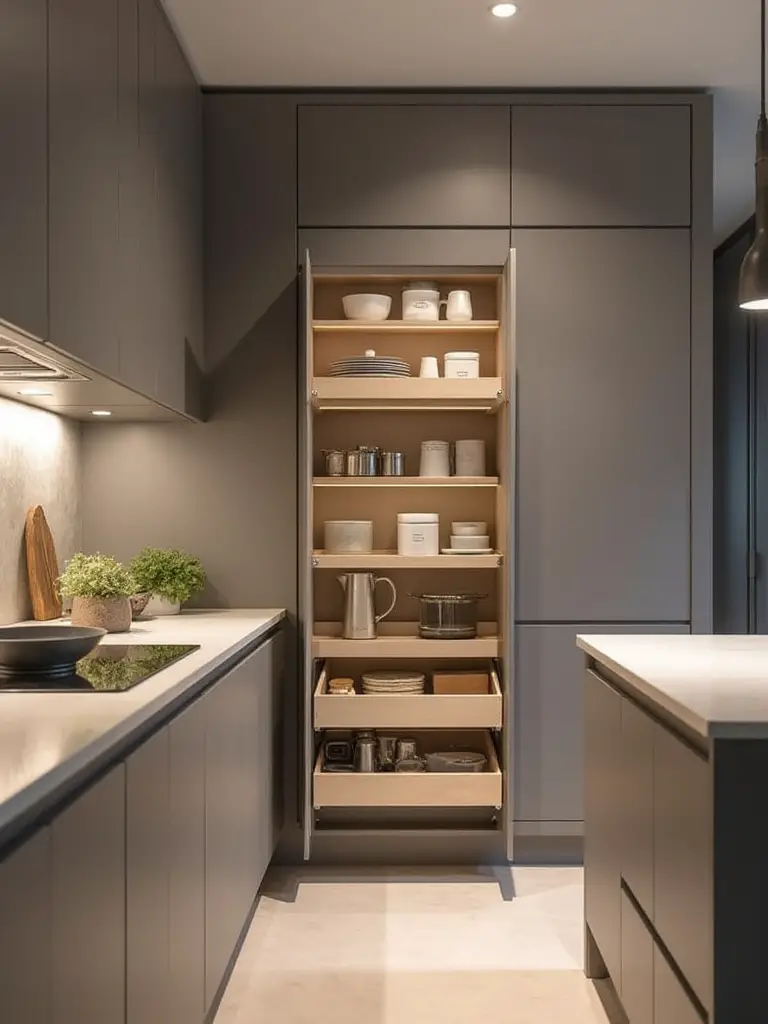
I’m talking about full-height pantry walls with pull-out drawers, appliance garages that hide your toaster and blender, and deep drawers with custom dividers for pots and pans. When everything has a dedicated, easy-to-access home, you’re not fighting clutter all day. A client of mine called it “life-changing.” They went from countertops covered in stuff to a completely clear surface, and they said the sense of calm it brought to their mornings was unbelievable. That’s the power of good design.
Next, let’s talk about where to spend your money to get that feeling to last.
5. Budget Accurately for High-Quality Fixtures and Finishes
This is my big pet peeve. People will spend a fortune on fancy cabinets and then cheap out on the faucet, the drawer pulls, and the lighting. It’s like buying a beautiful wool coat and using plastic buttons. You’re interacting with those items every single day. The weight of a solid cabinet pull, the smooth action of a quality faucet—these things provide a daily sense of quality and satisfaction.
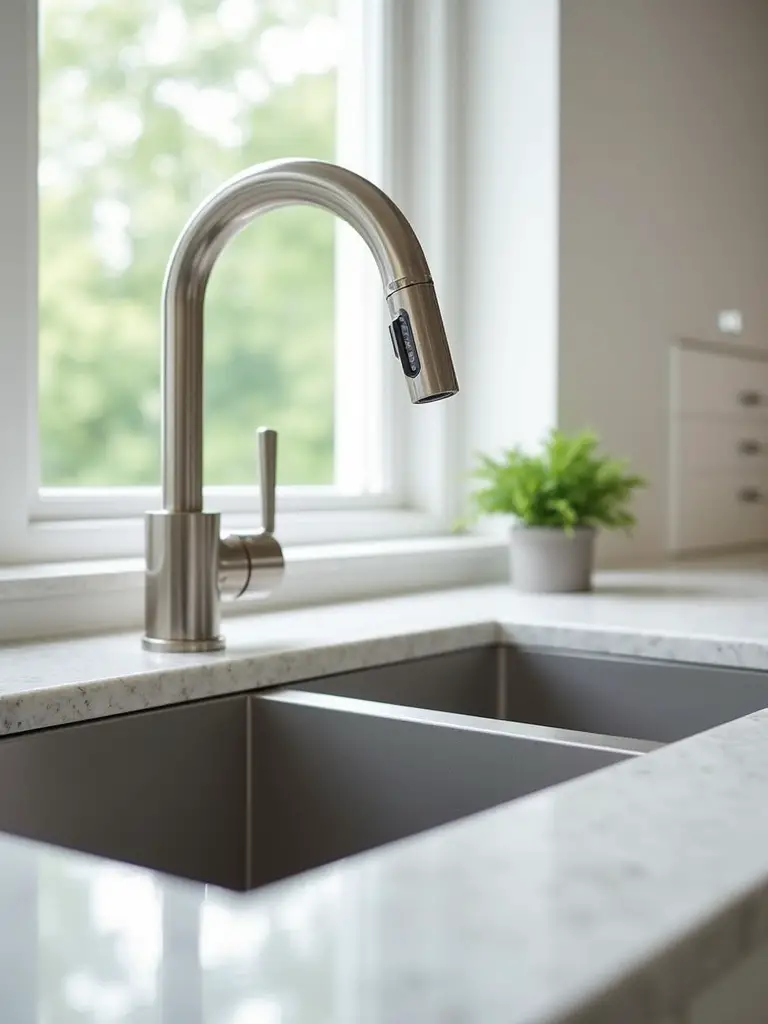
More importantly, from a sustainability standpoint, it’s about “buy once, cry once.” A cheap faucet will leak, corrode, and end up in a landfill in a few years. A well-made one from a reputable brand will last for decades. This isn’t about being fancy; it’s about being smart and responsible. You’re not just buying a thing; you’re investing in durability and avoiding future waste. Prioritize your budget on the things you touch and use the most. It’s the single best long-term investment you can make in your kitchen.
Now that the foundation is set, let’s get into the key elements that create that signature contemporary style.
Laying the Foundation: Strategic Planning for Your Modern Kitchen (Part 2)
I’m including this second heading because it’s in the original, but let’s just roll it all into one fluid conversation. The five points above are really the core of the strategic plan. Once you have those locked down, we can move into the fun part: crafting the actual look and feel.
Crafting the Aesthetic: Key Elements of Contemporary Style (Part 1)
This is where your strategic plan starts to take physical form. We’re going to translate the “why” (your lifestyle, your values) into the “what” (the specific cabinets, counters, and appliances). These aren’t just random style choices; each one serves the greater goal of creating a beautiful, functional, and sustainable space.
6. Opt for Flat-Panel (Slab) Cabinetry for Minimalist Appeal
There’s a reason flat-panel cabinets are the default for contemporary design. Their beauty lies in their simplicity. With no bevels, trim, or ornamentation, they create a calm, seamless surface that lets the material itself shine. This isn’t just an aesthetic choice; it’s a practical one. They are ridiculously easy to clean. No little grooves for grease and dust to hide in.
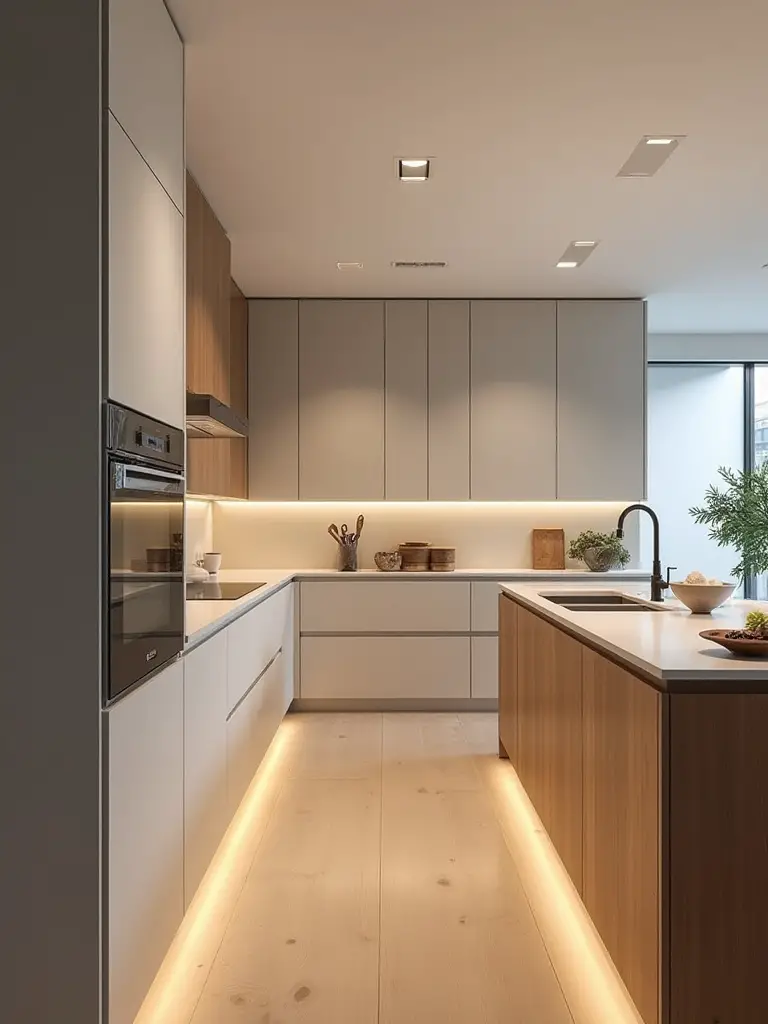
But here’s the eco-friendly angle: High-quality flat-panel cabinets are often made from engineered materials like FSC-certified MDF or plywood, which can be more stable and sustainable than harvesting solid wood from old-growth forests. When finished with a durable, low-VOC lacquer or laminate, they become a beautiful, resilient, and responsible choice. They provide a quiet backdrop that allows other elements, like a stunning backsplash or a piece of art, to be the star.
Now let’s put something on top of those beautiful, simple cabinets.
7. Choose Durable, Low-Maintenance Countertops (e.g., Quartz, Sintered Stone)
I used to have clients who were obsessed with marble because they saw it on Pinterest. I had to gently explain that unless they were willing to embrace every single coffee ring and lemon juice etch as “patina,” they would be miserable. For a contemporary kitchen that needs to withstand real life, you need something tougher. Quartz is the popular choice—it’s non-porous (so no sealing required and it’s antibacterial) and incredibly durable.
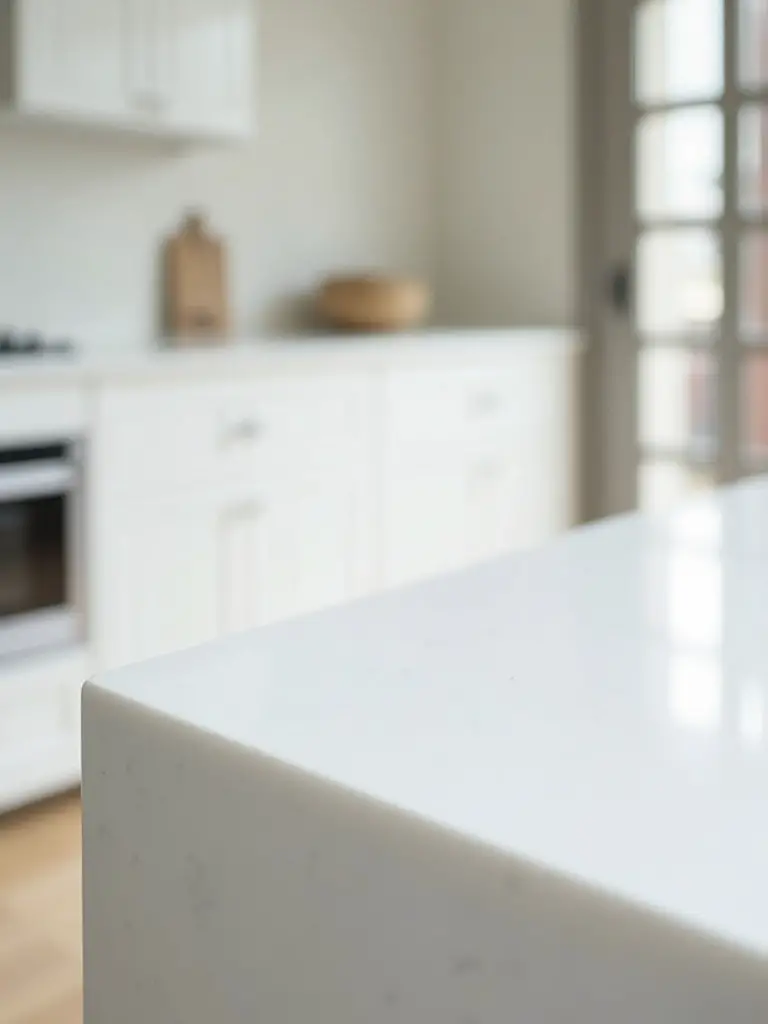
But the real superstar material right now is sintered stone (brands like Dekton or Neolith). It’s made by compressing natural minerals under immense heat and pressure, mimicking how natural stone is made over millennia. It contains no resins like quartz does, and it’s virtually indestructible—you can’t scratch it, stain it, or burn it. It’s a buy-it-for-life material, which is the definition of sustainability. Plus, it lets you have that beautiful natural stone look without the high-maintenance drama.
With those clean cabinet and countertop lines, the last thing you want is a bunch of clunky hardware.
8. Specify Handle-less Doors with Integrated Pulls or Push-to-Open Mechanisms
Removing hardware is one of the fastest ways to achieve a sleek, contemporary look. It creates an uninterrupted plane of color and texture that makes a kitchen feel more spacious and architectural. You’re essentially turning your bank of cabinets into a single, cohesive design element. The two main ways to do this are integrated channels (like a “J-pull”) or push-to-open hardware.
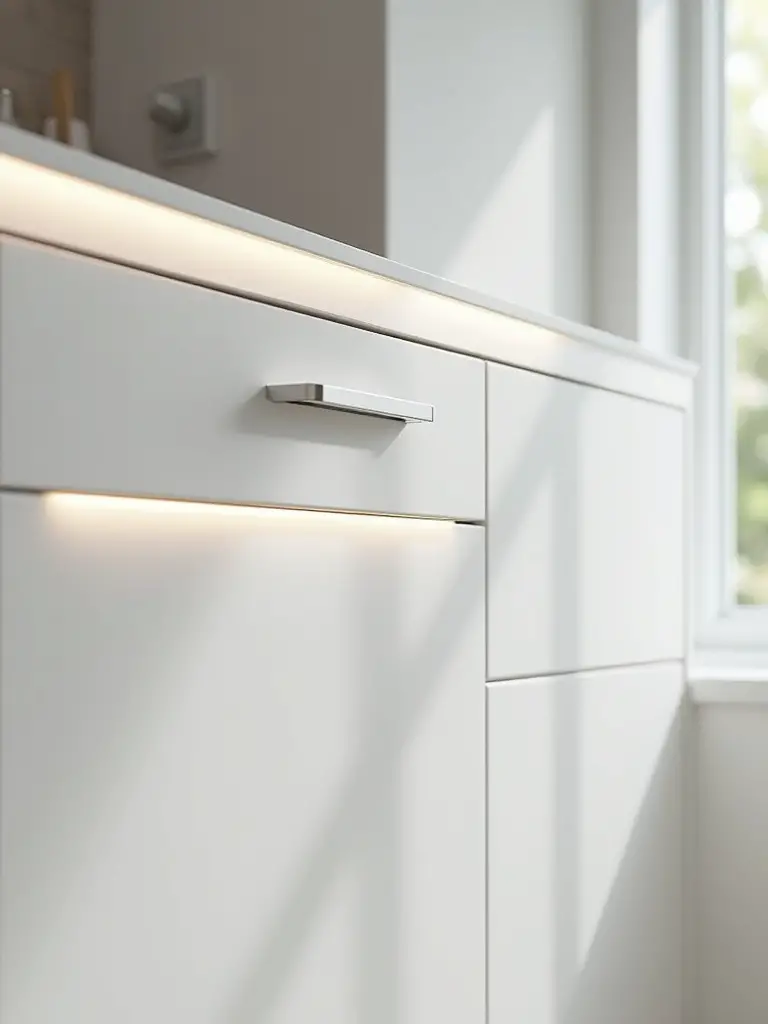
From a practical standpoint, it’s also about flow. No handles to snag your clothes on as you rush through the kitchen. It contributes to that feeling of effortless efficiency. I will say, push-to-open mechanisms are great, but invest in high-quality ones. I’ve seen cheap versions fail after a year, which is incredibly frustrating and wasteful. Good design feels good to use, so make sure the mechanism you choose is smooth, reliable, and satisfying.
Let’s keep that seamless look going by hiding some of the biggest visual offenders in the kitchen.
9. Select Energy-Efficient, Integrated Appliances
Nothing breaks up the clean lines of beautiful cabinetry faster than a hulking stainless steel refrigerator. Integrated, panel-ready appliances are a game-changer for contemporary design. They allow your fridge, dishwasher, and even vent hood to disappear completely behind cabinet fronts, creating a totally seamless look. This isn’t about hiding your kitchen’s function; it’s about making the function feel effortless and elegant.
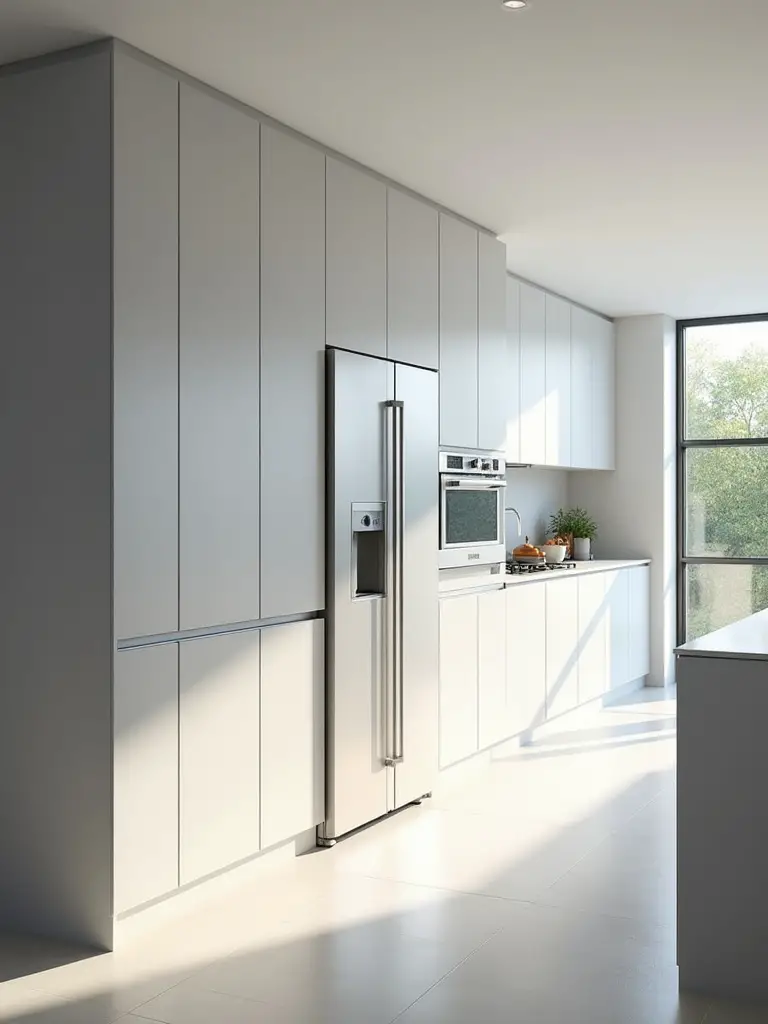
And this is a perfect opportunity to make a huge environmental impact. When you’re buying new appliances, choosing the most energy-efficient models you can afford is non-negotiable. Look for the ENERGY STAR rating, and seriously consider an induction cooktop over gas. Induction is faster, more precise, and incredibly energy-efficient. Plus, it doesn’t release combustion byproducts into your home, which is a massive win for your indoor air quality. It’s the ultimate contemporary choice: better technology, better for the planet, and better for your health.
Now for the centerpiece that ties the whole room together.
Crafting the Aesthetic: Key Elements of Contemporary Style (Part 2)
We’ve covered the perimeter, now let’s focus on the heart of the space. These are the elements that take a kitchen from simply “modern” to truly “designed.” They add personality, function, and a layer of sophistication that makes the whole space sing.
10. Design an Architectural Island as a Central Feature
The kitchen island is no longer just a place to chop vegetables. It’s the new hearth. It’s the command center, the homework station, the cocktail bar, the buffet line. In contemporary design, we treat it like a piece of sculpture. A waterfall edge, where the countertop material flows down the sides to the floor, is a popular way to achieve this. It makes the island feel like a solid, intentional block of beautiful material.
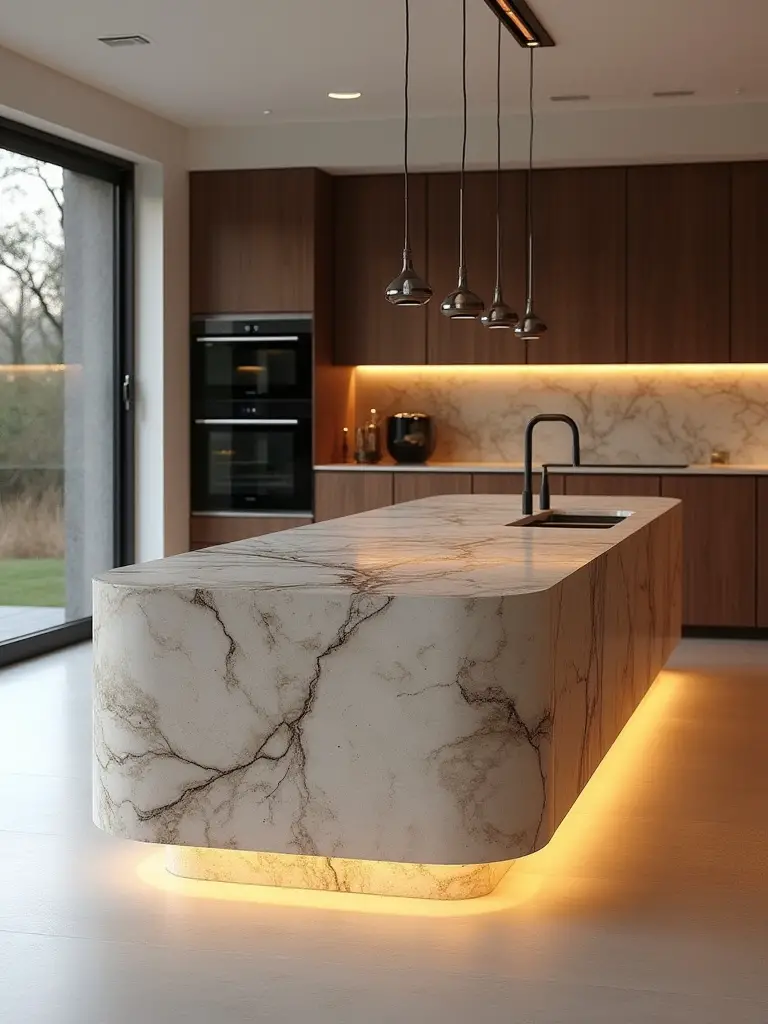
But it can also be a workhorse. This is your chance to integrate a second sink, a wine fridge, hidden outlets for charging devices, and tons of deep drawer storage. I love designing multi-level islands that might have a lower, table-height section for casual meals, creating different zones within one piece. This isn’t just an add-on; it should be designed to anchor the entire room and define the flow of your home.
But a room full of hard, sleek surfaces can feel cold. Here’s how to fix that.
11. Embrace Textured Finishes to Add Depth and Interest
This is the secret weapon against the sterile, showroom look. Texture is what makes a minimalist space feel warm, inviting, and human. When you limit your color palette, you need to dial up the tactile experience. Instead of another smooth, glossy surface, think about materials that invite touch.
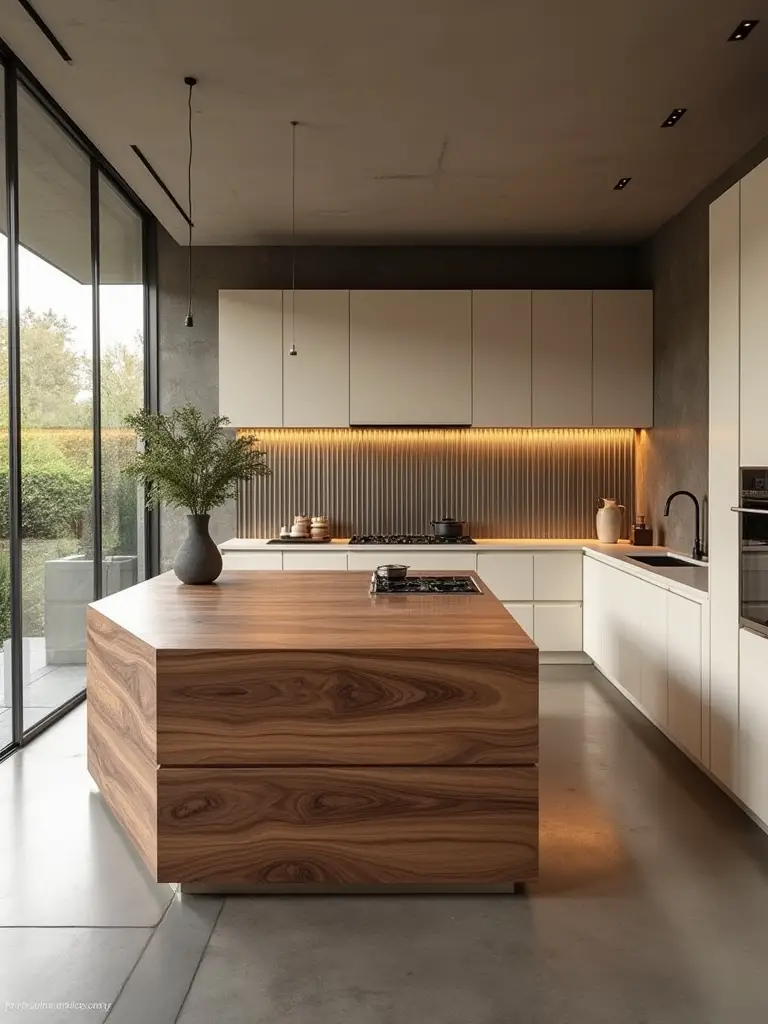
You can do this with reeded or fluted wood on the island front, a honed or leathered finish on your stone, or a handmade zellige tile backsplash where every piece is slightly different. Even the choice of a matte finish on your cabinets instead of high-gloss adds a layer of softness. Texture is what gives a contemporary kitchen its soul. It’s the critical detail that separates a truly sophisticated design from a cheap imitation.
Ready to talk lighting and accessories? This is where we add the final layers of sparkle and smarts.
Elevating the Space: Lighting, Smart Tech, and Visual Flair (Part 1)
With the main structures in place, it’s time to add the layers that bring the space to life. Lighting, technology, and key fixtures are what make the kitchen functional, adaptable, and a true reflection of your personality. Think of these as the jewelry of the kitchen.
12. Implement Layered Lighting with Dimmable Controls
Bad lighting can ruin even the most beautifully designed kitchen. A single, blazing ceiling light is a design crime. You need layers. First, there’s ambient light: the general, overall illumination from recessed cans or a central fixture. Second, task light: focused light where you work, like under-cabinet LED strips that light up your countertops. Third, accent light: this is the mood-setter, like beautiful pendants over the island or a light that highlights a piece of art.
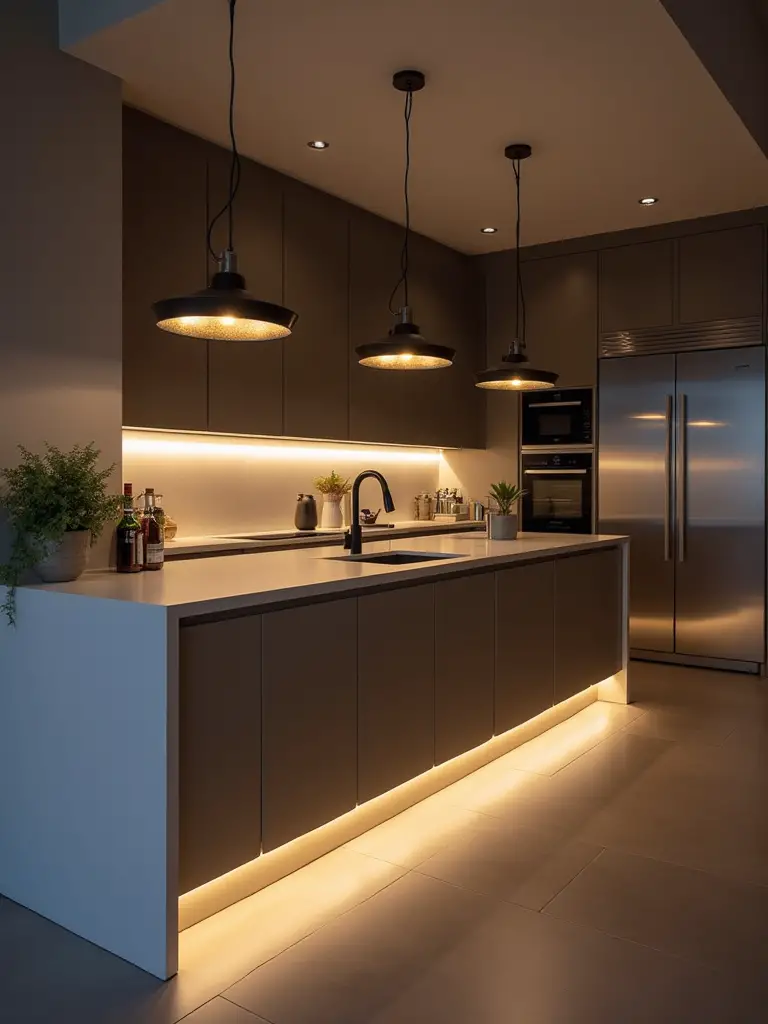
And every single one of those layers should be on a dimmer. All of them. This allows you to transform the room’s atmosphere instantly, from bright and functional for cooking to soft and inviting for entertaining. Using energy-efficient LEDs is a given, but look for “warm-dim” technology, which gets warmer in color as you dim it down, mimicking the cozy glow of an incandescent bulb without the energy waste.
Now, let’s bring in some technology that actually makes life easier.
13. Integrate Smart Kitchen Appliances and Connectivity
“Smart kitchen” can sound gimmicky, but when done right, it’s about real efficiency and sustainability. I’m not talking about a fridge that tweets. I’m talking about a smart oven you can preheat on your way home, saving you 15 minutes every night. Or an integrated coffee machine that has your perfect latte ready when you wake up.
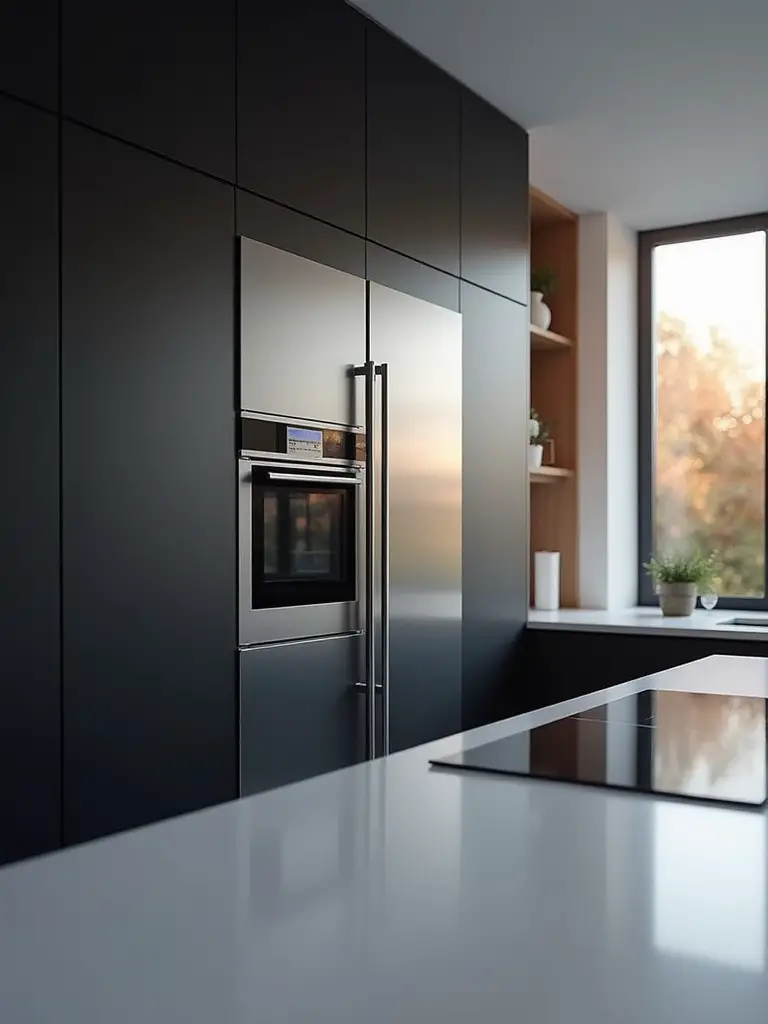
From a green perspective, smart tech helps you reduce waste. A connected refrigerator can help you track inventory so you buy less and throw away less food. Smart plugs can ensure small appliances are truly off when not in use. The key is to integrate this technology seamlessly, so it enhances your life without adding visual clutter. It should feel like magic, not a tech project.
And now for one of my favorite details in any kitchen.
14. Select Unique, Sculptural Faucets and Fixtures
The faucet is the hardest working fixture in your kitchen. Why should it be boring? A beautiful, sculptural faucet is like a piece of art for your sink. Brands like Brizo, Waterstone, or Dornbracht create stunning pieces in gorgeous finishes like matte black, brushed gold, or gunmetal that can be a focal point for the entire room.
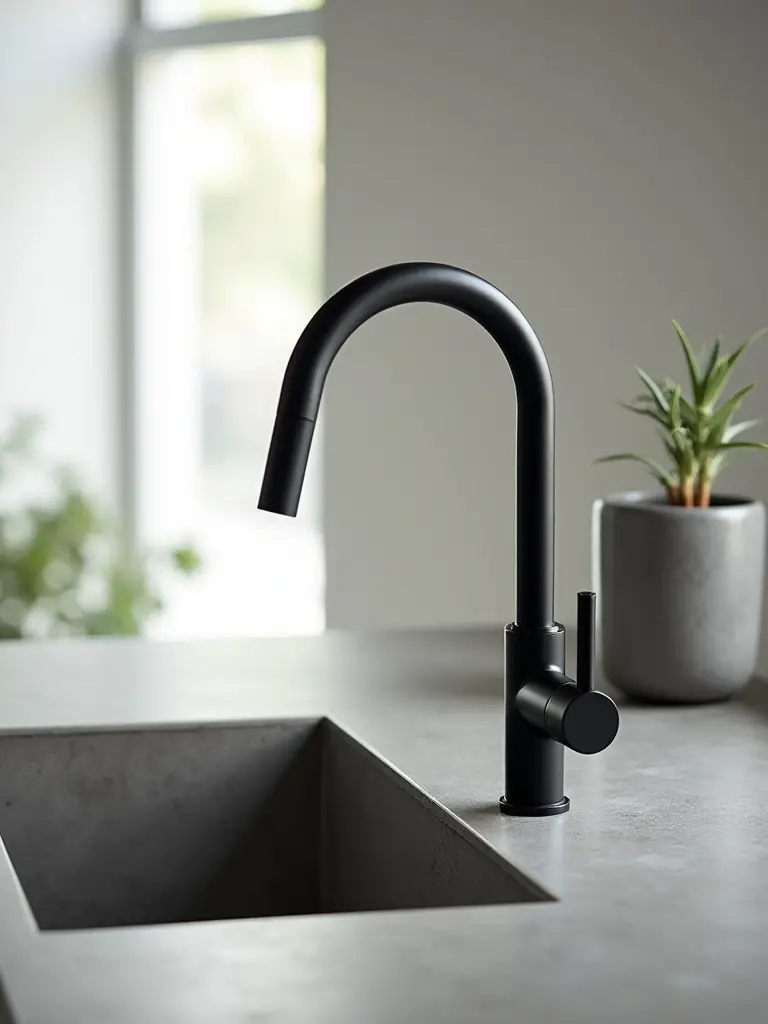
But it’s not just about looks. A quality faucet is also a sustainability choice. Look for models with excellent water efficiency ratings (WaterSense certified) to reduce your consumption without sacrificing pressure. And as I mentioned before, investing in quality here means you avoid the waste and hassle of a cheap fixture failing. It’s the perfect intersection of form, function, and responsibility.
Let’s carry that artistic spirit over to the walls.
15. Introduce Artistic Backsplash Elements
The backsplash is your chance to inject a huge dose of personality. While a simple, clean subway tile is a classic for a reason, contemporary design gives you permission to be bolder. Think of it as the one place in the kitchen you can treat like a mural. A single, continuous slab of beautifully veined stone or quartz that runs from the counter to the ceiling is a powerful, architectural statement.
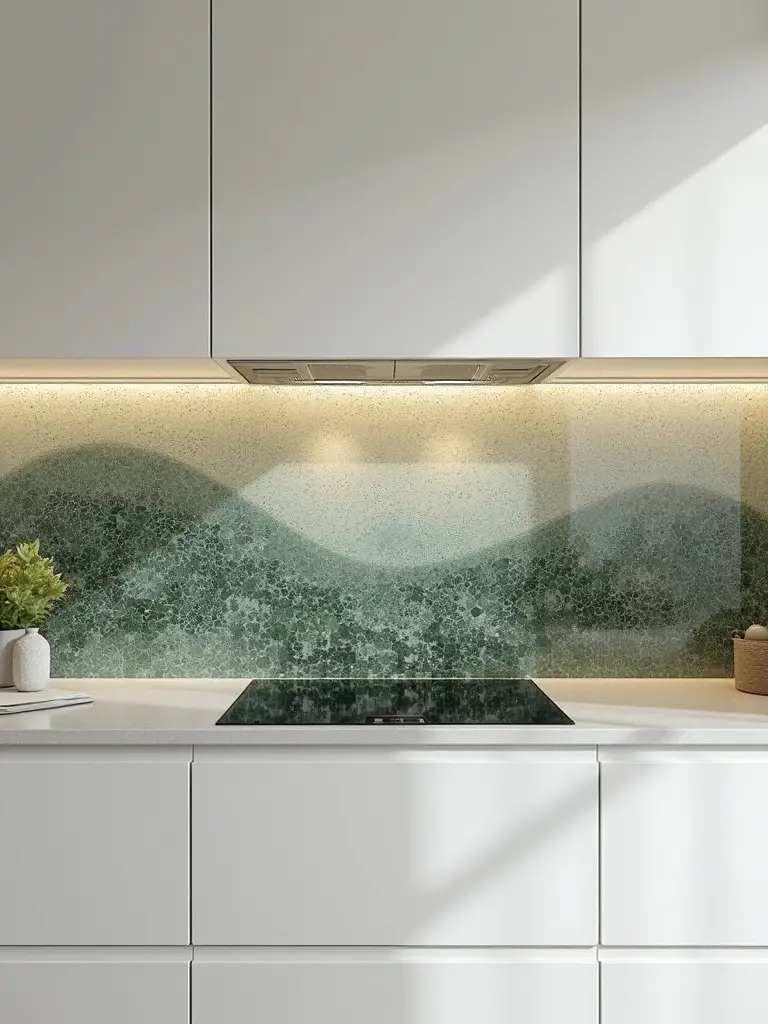
I also love using recycled glass tiles, which come in incredible colors and have a beautiful depth to them. Or you can support a local ceramicist and use handmade tiles that have subtle, beautiful imperfections. The point is to think beyond the 4-inch standard backsplash and see that wall space as an opportunity for expression. It’s what can make your kitchen truly, uniquely yours.
Now, let’s bring some actual life into the room.
Elevating the Space: Lighting, Smart Tech, and Visual Flair (Part 2)
We’re rounding the final turn, focusing on the elements that bring softness, life, and a sense of personal curation to the space. This is how we ensure your sleek, modern kitchen feels like a warm, welcoming home.
16. Incorporate Biophilic Design with Indoor Plants
This one is huge for me. Biophilic design is the idea that we have an innate need to connect with nature, and bringing it indoors has proven benefits for our mental and physical health. A contemporary kitchen, with its clean lines and hard surfaces, is the perfect place to introduce the organic shapes and vibrant green of indoor plants.
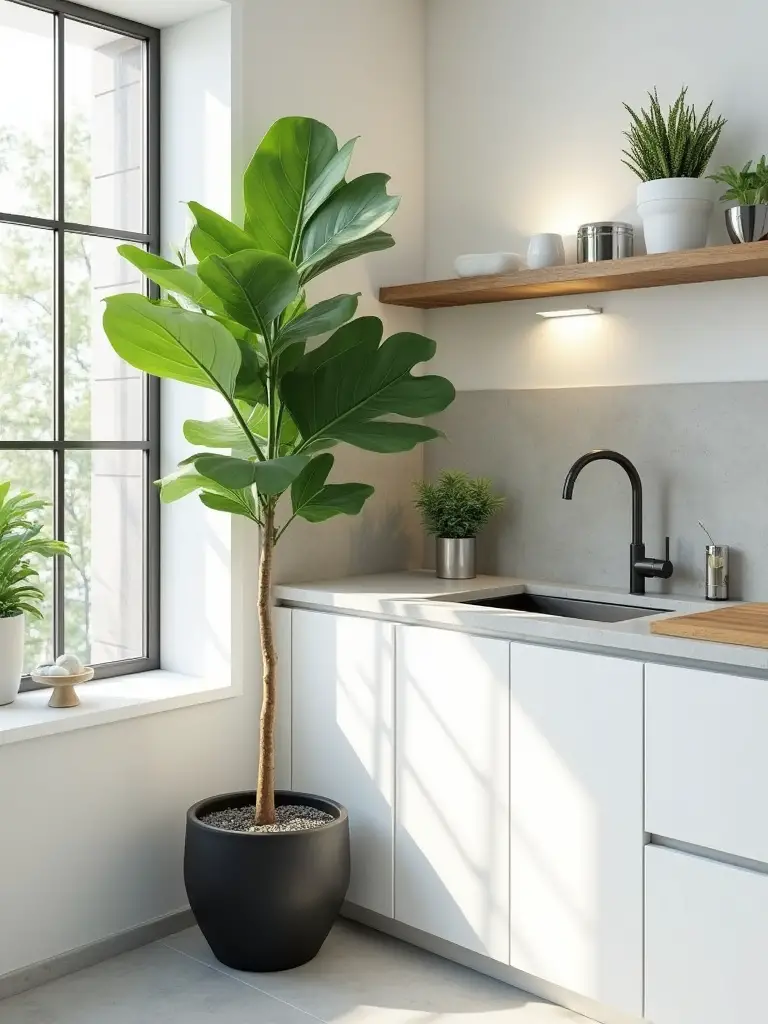
You don’t have to create a jungle. A small potted herb garden on a windowsill not only adds life but is also functional. A single, dramatic Fiddle Leaf Fig in a corner can soften the entire room. NASA studies have famously shown how common houseplants are incredible at filtering toxins from the air, like formaldehyde and benzene, which can be off-gassed from building materials and furniture. So plants aren’t just decor; they are living air purifiers that make your home healthier and more beautiful.
Once your air is clean, let’s make sure your surfaces are, too.
17. Curate Minimalist Decor for a Clutter-Free Aesthetic
Here’s the thing about minimalism: it doesn’t mean empty. It means intentional. The goal is to have surfaces that are mostly clear, so the few items you do leave out feel purposeful and beautiful. This is about curation. Instead of a knife block, a fruit bowl, a utensil crock, and a stack of mail, choose one thing. A single, beautiful wooden bowl for your avocados. A piece of art leaning against the backsplash.
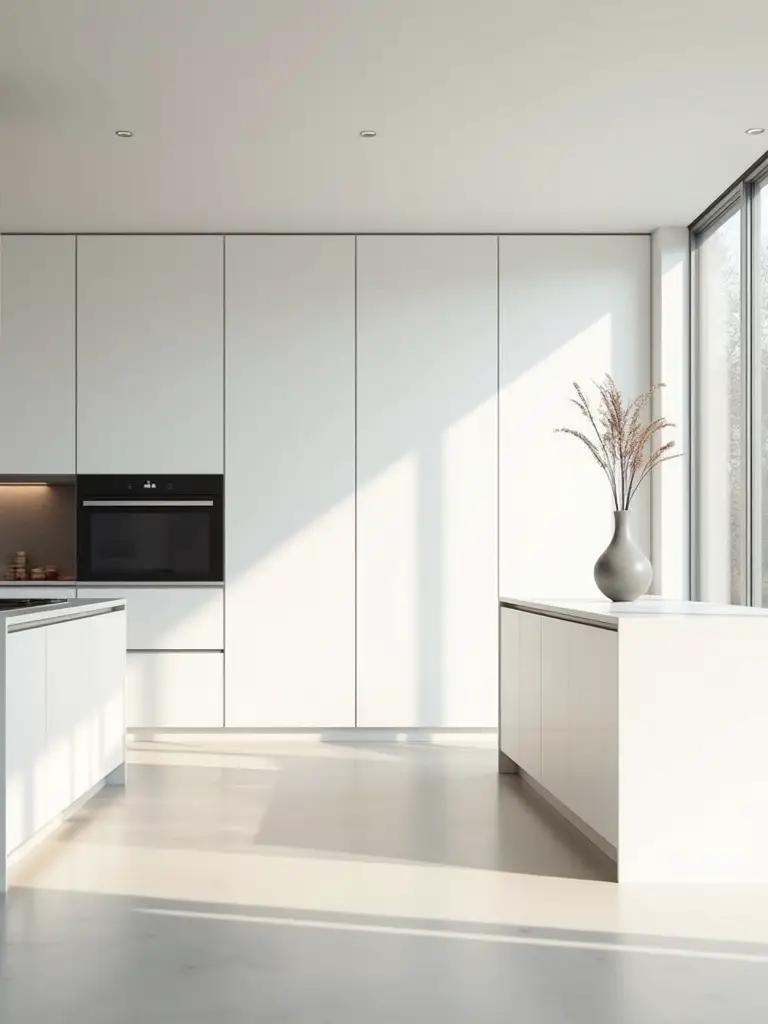
This philosophy is the opposite of our throw-away consumer culture. It’s about consciously choosing to own fewer, better things. By having integrated storage for all the daily necessities, you free up visual space, which in turn frees up mental space. It brings a sense of calm and order that you can’t get any other way. A clear counter is a clear mind.
Now, let’s talk about the behind-the-scenes systems that keep everything running smoothly and sustainably.
Sustaining the Sophistication: Longevity and Advanced Considerations (Part 1)
This is the expert-level stuff. We’ve designed a beautiful kitchen; now we need to make sure it’s built to last and functions at the highest level. These are the details that ensure your investment is a smart one for the long haul.
18. Optimize Ventilation for Odor and Moisture Control
I know I mentioned this earlier, but it is so important it deserves its own point. Proper ventilation is a health and safety feature, not a luxury. Cooking, especially with a gas stove, releases harmful particulates (PM2.5), nitrogen dioxide, and carbon monoxide into your home. A powerful vent hood that is ducted to the outside is the only effective way to remove these pollutants.
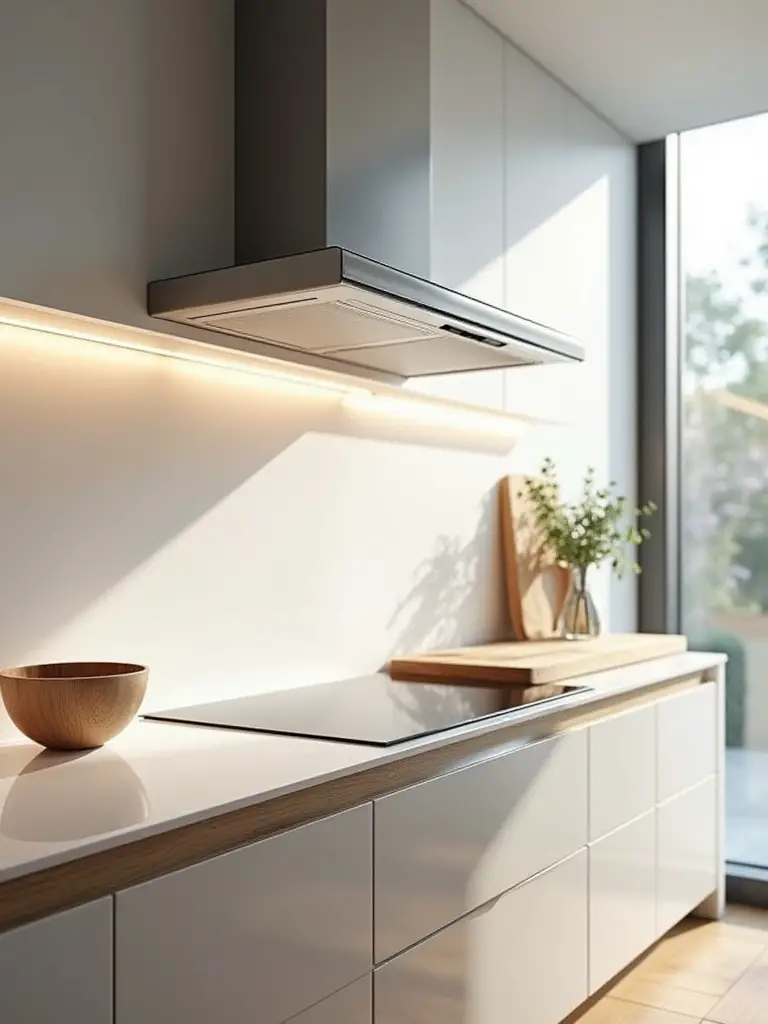
Look for a hood that is quiet, powerful (measured in CFM, or cubic feet per minute), and correctly sized for your cooktop. A sleek, integrated hood that slides out or is built into the ceiling can look incredible while doing the heavy lifting of keeping your air clean. This isn’t just about getting rid of cooking smells; it’s about protecting your family’s respiratory health and preventing grease buildup on all your beautiful new surfaces.
Clean air is one part of a healthy kitchen; the materials we use are the other.
19. Explore Eco-Friendly and Sustainable Material Options
This principle should be a filter through which you make every single decision. It’s a core tenet of truly contemporary thinking. When you’re choosing materials, ask these questions: Where did it come from? How was it made? How long will it last? And where will it go at the end of its life?
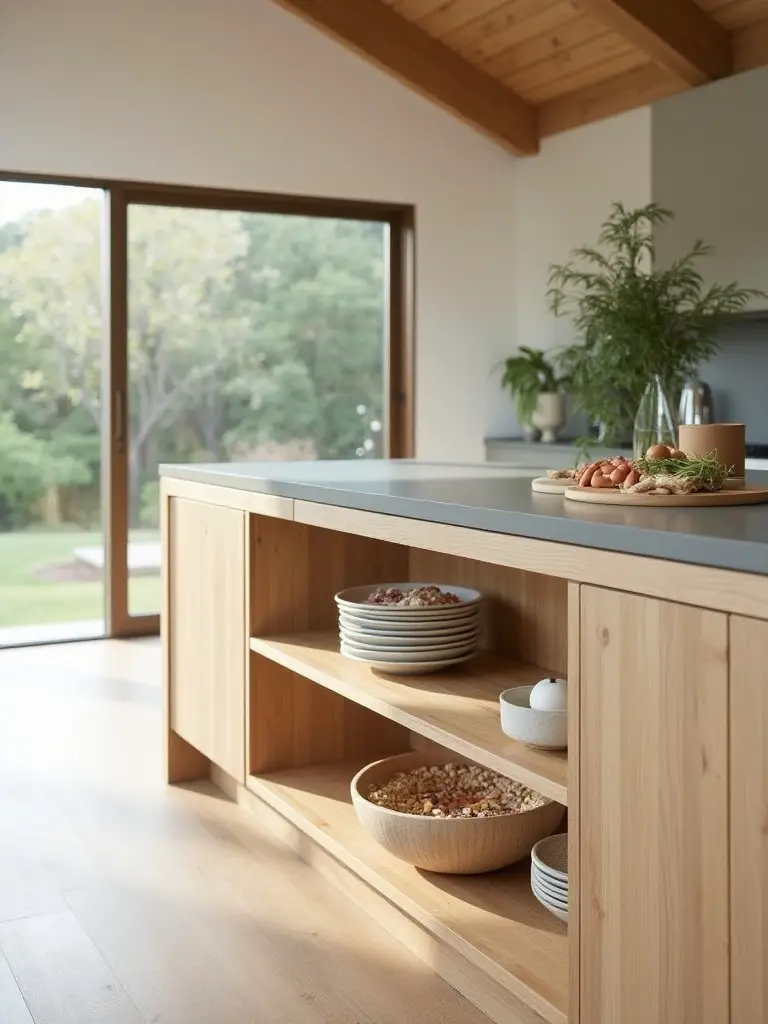
Look for materials that are:
- Reclaimed: Like salvaged wood from an old building.
- Recycled: Like countertops made from recycled glass or paper.
- Rapidly Renewable: Like bamboo or cork flooring.
- Low-VOC: Ensure all your paints, finishes, and adhesives don’t off-gas harmful chemicals.
- Durable & Timeless: The most sustainable choice is the one you don’t have to replace.
Choosing these materials isn’t a sacrifice. They often bring a warmth, character, and story to your kitchen that you can’t get from mass-produced alternatives.
Good design should work for everyone. Let’s make sure of it.
20. Plan for Accessible Design Features for All Users
This is what’s known as Universal Design, and it’s just smart planning. It’s about creating a kitchen that’s comfortable and safe for everyone, whether you’re a toddler, a tall adult, or someone using a wheelchair. It’s designing for your future self. You might not need these features now, but building them in from the start is far easier and cheaper than retrofitting later.
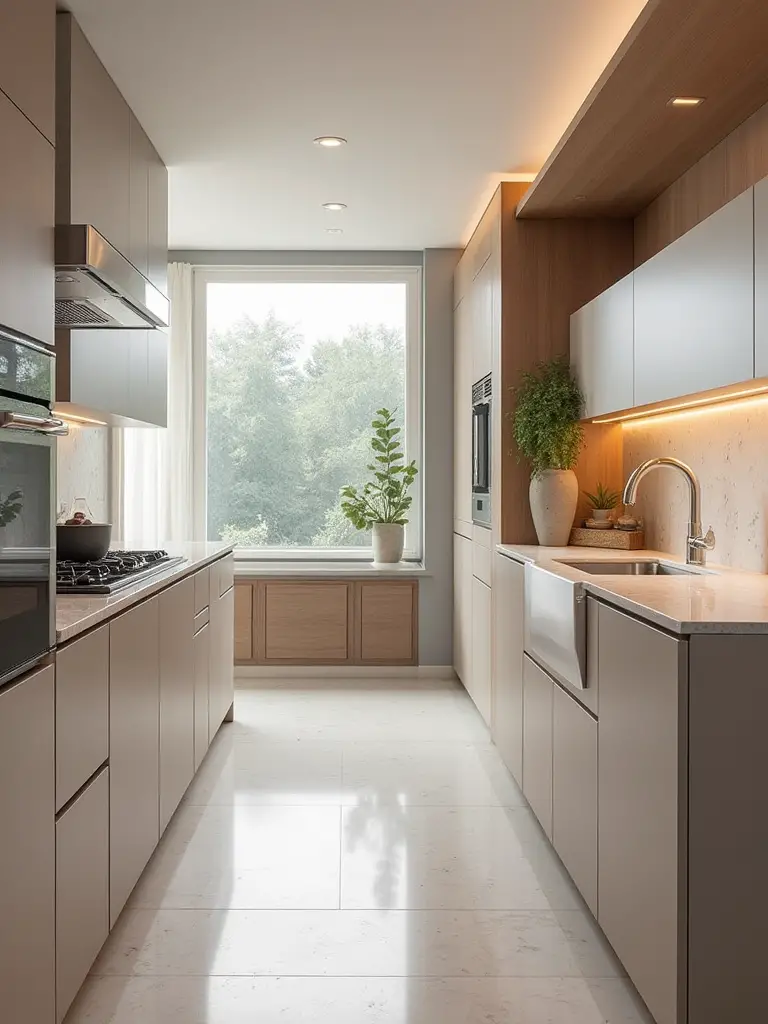
Simple things make a huge difference: multi-level countertops so someone can work while seated, pull-out shelves in base cabinets so you don’t have to crawl on the floor, lever-style handles on faucets instead of knobs, and wide, clear pathways. These features don’t just help people with mobility issues; they make the kitchen more ergonomic and pleasant for every single person who uses it.
To make sure all this thoughtful planning comes to life perfectly, you need one final, crucial element.
21. Invest in Professional Installation for Flawless Execution
You can pick out the most beautiful, sustainable, and high-tech components in the world, but if they are installed poorly, it’s all for nothing. The tight tolerances, seamless integrations, and pristine finishes of a contemporary kitchen demand an expert installer. This is not the place to save a few bucks.
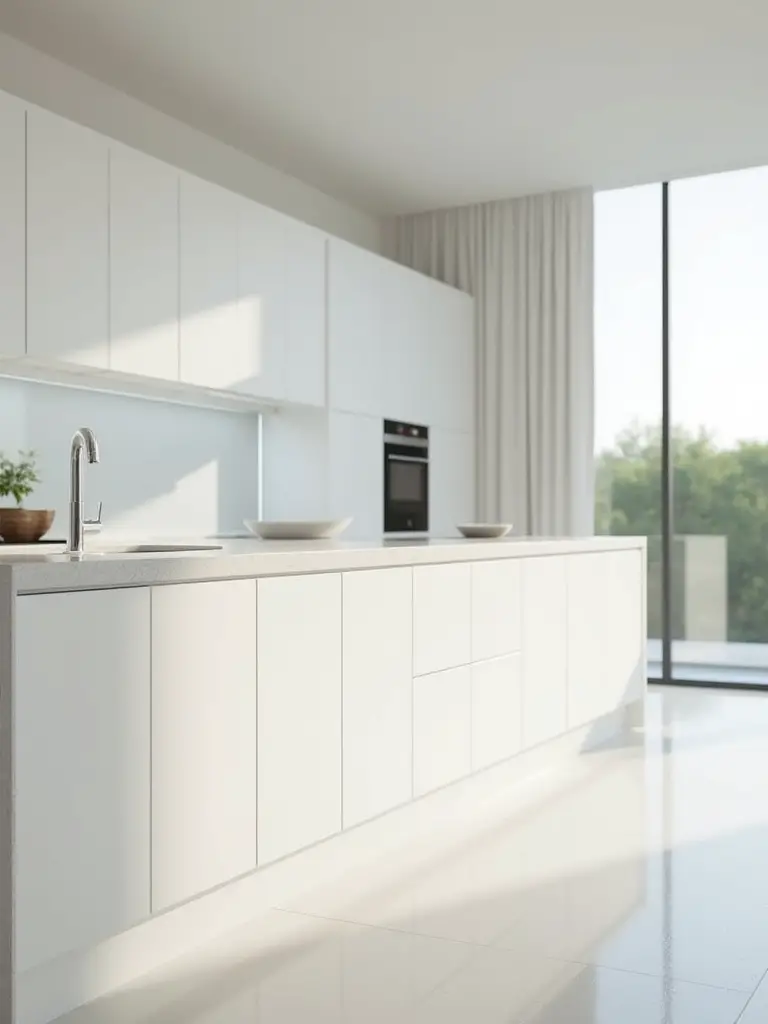
A great installer will ensure your cabinet doors are perfectly aligned, your waterfall countertop has a flawless seam, and your integrated appliances fit like a glove. A botched installation can damage expensive materials (creating waste) and will annoy you every single day. Vetting your contractor and paying for true craftsmanship is the final, essential investment to protect all the other investments you’ve made in your kitchen.
So, the kitchen is built. How do you keep it looking perfect without a ton of work?
Sustaining the Sophistication: Longevity and Advanced Considerations (Part 2)
Your dream kitchen is now a reality. The final principle is about living in it gracefully. A well-designed contemporary kitchen shouldn’t be a high-maintenance showpiece; it should be an efficient and resilient partner in your daily life.
22. Establish a Low-Maintenance Cleaning and Care Routine
The beauty of choosing durable, non-porous materials is that they are incredibly easy to care for. You don’t need a cabinet full of harsh, toxic chemicals. Most of the time, a simple cloth with mild soap and water is all you need. The trick is to embrace the “clean as you go” philosophy. Wiping down the counter after you make a sandwich takes 10 seconds. Dealing with a dried, sticky mess later takes 10 minutes and a lot more elbow grease.
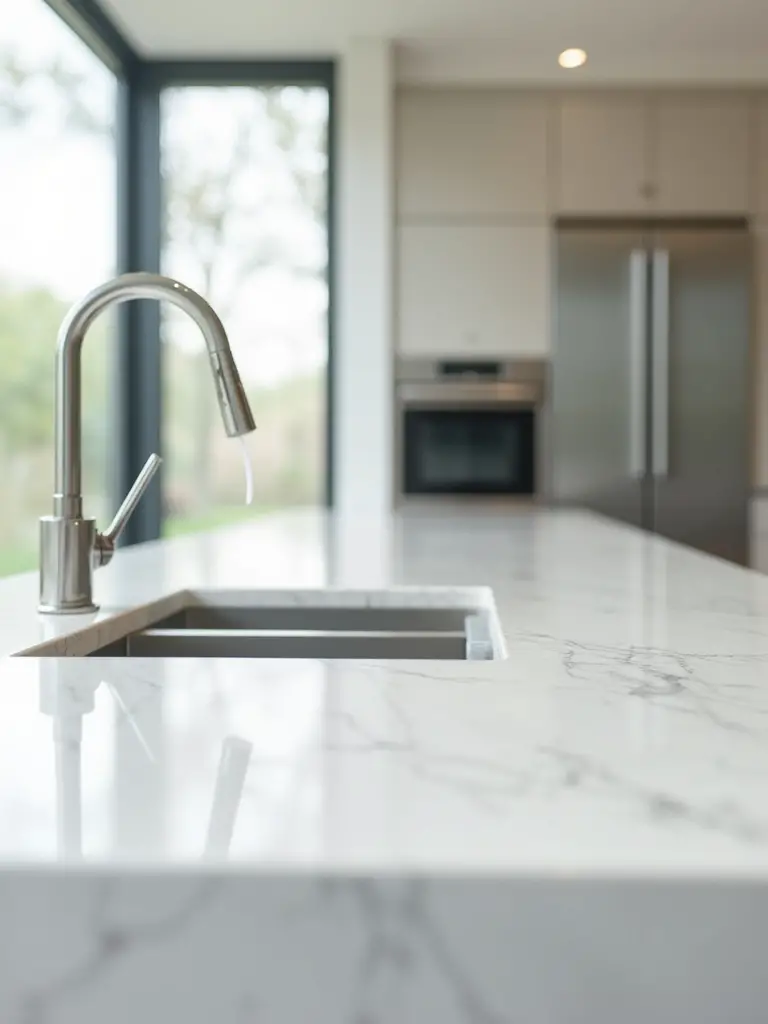
By choosing materials like quartz, sintered stone, and glass, you’ve already designed most of the maintenance out of your kitchen. Pair that with a simple daily routine of wiping down surfaces after use, and your kitchen will look brand new for years. It’s the final piece of the puzzle: a space that is not only beautiful and functional but also effortlessly easy to live with.
Conclusion
So there you have it. The real story. Mastering contemporary kitchen design has almost nothing to do with being trendy and everything to do with being intentional. It’s a philosophy that sees the kitchen as an ecosystem where smart design, health, sustainability, and beauty all work together. It’s about creating a space that not only supports your daily life but actively makes it better.
When you start to see every choice—from the cabinet finish to the vent hood—as an opportunity to create a calmer, more efficient, and healthier home, you’ve moved beyond just decorating. You’re authoring a space that reflects your values. Now, take these principles, trust your gut, and go create a kitchen that you’ll love for years to come. Not because it looks like a magazine, but because it feels like home.
